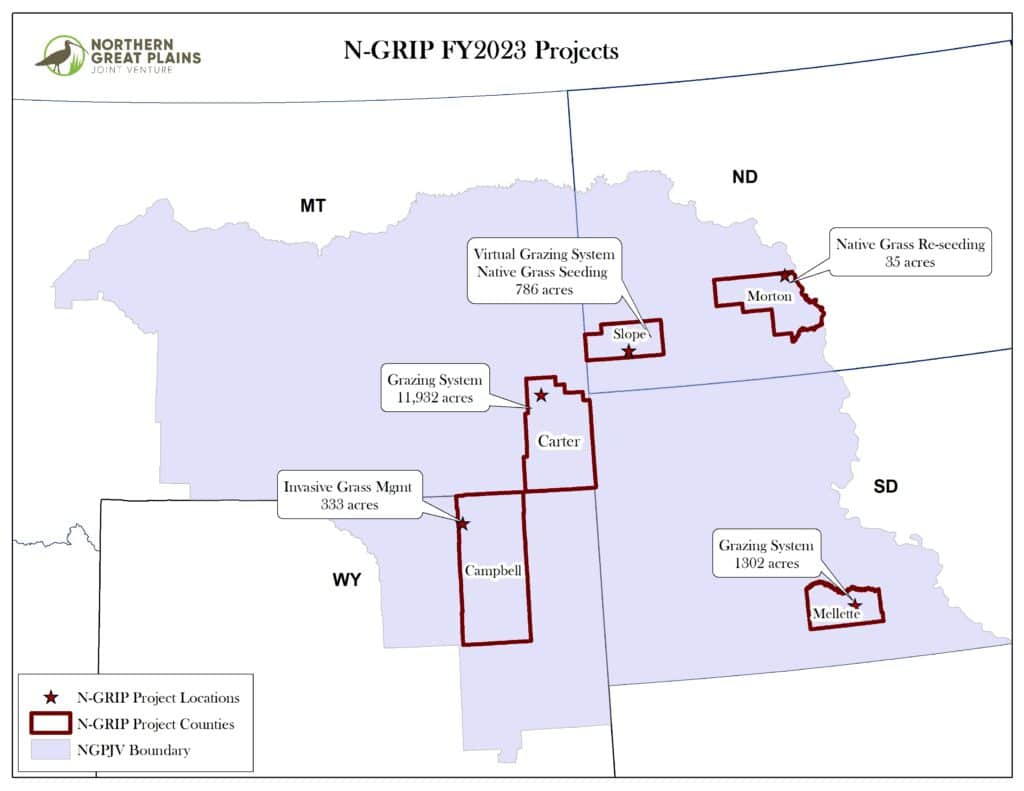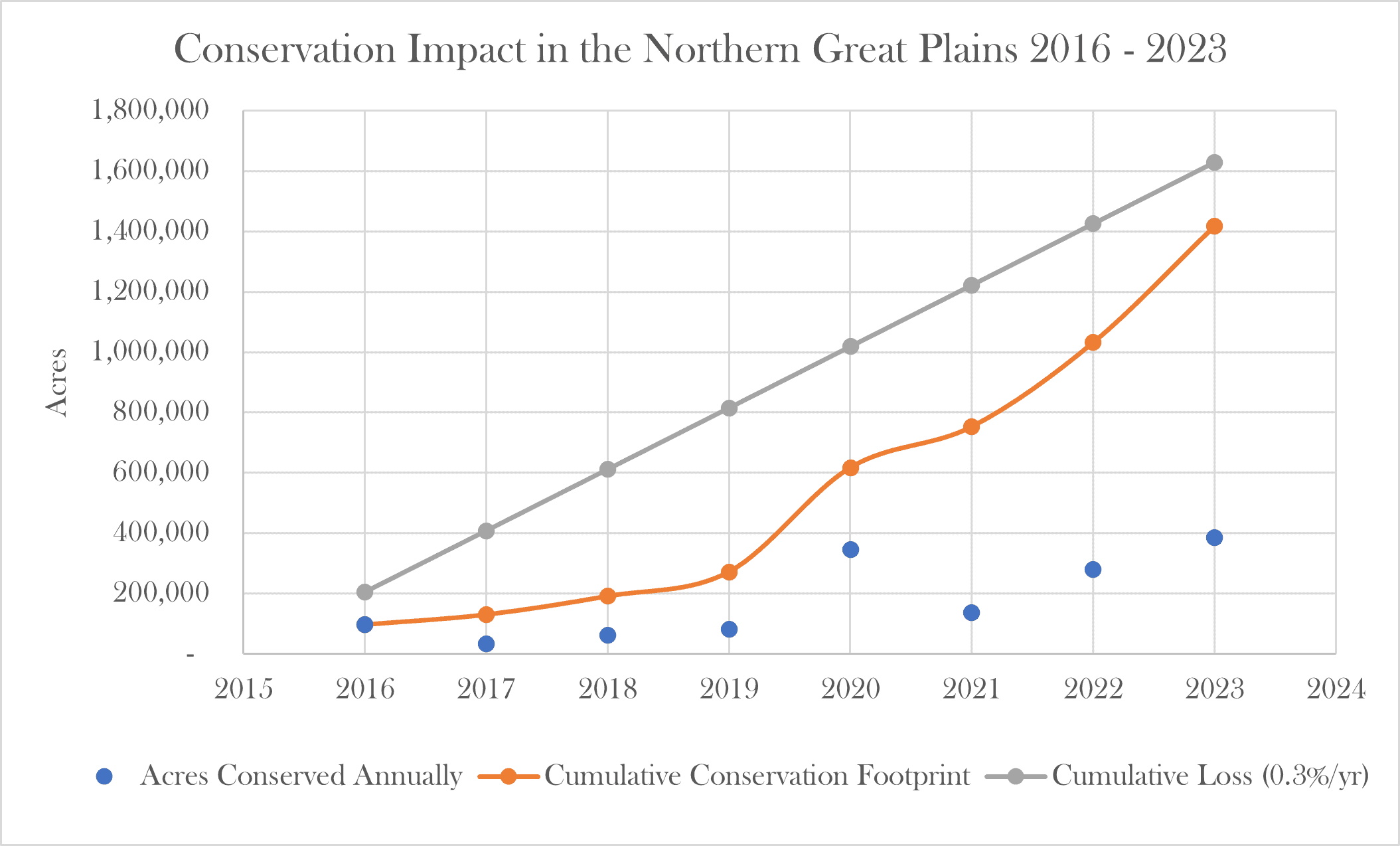The sum of cooperative conservation is greater than its parts. By showcasing the work of our partners and communicating the value of our combined footprint, the NGPJV is helping to demonstrate how we are, together, making an impact in the grasslands. To set ambitious yet realistic conservation goals, the NGPJV quantified population objectives for five declining grassland-obligate bird species in the region and the predicted amount of habitat conservation required to achieve these objectives. While many factors may influence declining trends for these five species, habitat loss is one of the key drivers. Habitat targets for each species were calculated as the range of acres needed to achieve NGPJV population objectives, focusing on breeding habitat.
Based on these calculations, approximately 1-2.5 million acres of conservation are required to meet objectives for all five priority grassland bird species in the NGPJV geography by 2026. In FY 2023, the NGPJV and partners addressed habitat loss and declining population trends by enhancing, restoring, or retaining 385,611 acres of habitat in the region (Tables 1 & 2), representing a total $12.7 million investment. The NGPJV and partners have conserved 1,416,913 acres since 2016, moving closer to our habitat objectives and helping to mitigate the impact of ongoing conversion (Figure 1, above).
Tables 1 & 2: Acres conserved by NGPJV partners in FY23 by project type and habitat type, respectively.
| Project Type | Acres |
|---|---|
| Enhance | 195,455 |
| Establish | 7 |
| Protect | 173,248 |
| Restore | 16,900 |
| TOTAL | 385,611 |
| Habitat Type | Acres |
|---|---|
| Mesic | 6 |
| Riparian | 2,517 |
| Upland | 376,830 |
| Wetland | 6,258 |
| TOTAL | 385,611 |
Accounting for the ongoing loss of ~235,000 acres or 0.3% of grasslands per year, the NGPJV estimates a net gain of 149,913 acres in 2023 through conservation efforts by our partners. These efforts positively impacted 268,859 grassland bird individuals from the five priority species. The conservation of 385,611 grassland acres is equivalent to 352,834,065 pounds of forage and supports over 100,000 estimated AUMs on working lands in the region (Animal Unit Month – 1 AUM is the amount of forage needed for a 1,000-pound cow to graze for one month). This is a huge value for livestock producers, as it provides enough forage to keep a herd of 17,674 cows fed through a 6-month grazing season. Conservation efforts also have the potential to sequester 10,099,399 metric tons of carbon, which is equivalent to the amount produced by 2 million gasoline-powered passenger vehicles in one year. The rangelands conserved by our partners over an 8-year period have an economic value of over $33.5 million, as measured by pasture rental rates (Table 3). Keeping grass in grass means keeping working lands working, and vice versa!
Table 3: Summary of conservation outcomes
| Year | Acres Conserved as Working Grasslands | Grass (pounds of forage) | Supports an Estimated # of AUMs | Carbon Sequestration Potential (Mt CO2e) | Grassland Birds Impacted | Economic Value (NASS pasture rental rates) |
|---|---|---|---|---|---|---|
| 2023 | 385,611 | 352,834,065 | 106,043.03 | 10,099,399 | 268,859 | $10,411,497 |
| 2022 | 278,668 | 254,981,220 | 76,633.70 | 715,623 | 199,684 | $6,688,032 |
| 2021 | 135,576 | 124,052,040 | 37,283.40 | 1,769,473 | 95,546 | $3,050,460 |
| 2020 | 345,462 | 316,097,730 | 95,002.05 | 4,477,835 | 245,148 | $7,600,164 |
| 2019 | 80,716 | 73,855,140 | 22,196.90 | 2,357,113 | 57,705 | $1,775,752 |
| 2018 | 61,105 | 55,911,075 | 16,803.88 | – | – | $1,283,205 |
| 2017 | 33,387 | 30,549,105 | 9,181.43 | – | – | $717,821 |
| 2016 | 96,388 | 88,195,020 | 26,506.70 | – | – | $2,024,148 |
| 1,416,913 | 1,296,475,395 | 389,651 | 19,419,444 | 866,942 | $33,551,079 |
The NGPJV provides funding for targeted habitat projects through our Northern Grassland Restoration Incentive Program (N-GRIP). During FY23, we completed four N-GRIP projects with support from a National Fish & Wildlife Foundation (NFWF) SPIRIT grant (see Figure 2) and have another 12,000+ acres of projects in the works, which are being funded by NFWF, ConocoPhillips, and an award from the World Wildlife Fund specifically for grass seedings. We also received a 2023 NFWF Northern Great Plains grant, which provides ~$200,000 for habitat projects. Half of the awarded funds were directly sub-awarded to South Dakota Game, Fish, and Parks for projects in the state beginning in 2024.
The four projects completed through N-GRIP funds in FY23 conserved 14,388 acres in Montana, Wyoming, South Dakota, and North Dakota. Of those acres, 155 were restored through a native grass seeding, with the remaining acres enhanced. All projects are expected to benefit grassland bird habitat and populations. The majority of the funded projects were for grazing systems – specifically, livestock water infrastructure and cross-fencing as well as a virtual fence project in ND. These projects not only benefit grassland habitat but also support working ranches. On two of the projects, the JV was a contributing partner in larger partner projects via N-GRIP. The partners involved in the collaborative projects were World Wildlife Fund and Pheasants Forever in MT and Ducks Unlimited and Audubon in ND. Without the support of the NGPJV and the flexibility of N-GRIP, the projects would not have been completed fully. Partnerships are one of the most important ways to meet large conservation goals – for both resilient grasslands and grassland-obligate birds. Through the work of the JV and many partners, we are well on our way to meeting our conservation goals by 2027!


